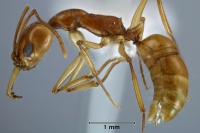Anochetus veronicae
| Anochetus veronicae | |
|---|---|

| |
| Scientific classification | |
| Kingdom: | Animalia |
| Phylum: | Arthropoda |
| Class: | Insecta |
| Order: | Hymenoptera |
| Family: | Formicidae |
| Subfamily: | Ponerinae |
| Tribe: | Ponerini |
| Genus: | Anochetus |
| Species: | A. veronicae |
| Binomial name | |
| Anochetus veronicae Shattuck & Slipinska, 2012 | |
Anochetus veronicae is the only species within the genus to invade the drier desert regions of northern Australia. However, even here the limited biological information suggests that it occurs in open woodlands, similar to the forest preferences shown by most other species.
Identification
Propodeal angles produced as spines; sculpture on front of head extending only slightly beyond eyes; body small (head length < 1.62mm, head width < 1.44mm); scape relatively short (scape length < 1.50mm); mesonotum smooth, lacking rugae or striations. This species is similar to Anochetus alae but differs in being smaller and with a shorter scape, having the mesonotum smooth and the sides of the propodeum with coarse striations, and with reduced pubescence on the scapes. It can be separated from the otherwise similar Anochetus renatae by the presence of teeth at the propodeal angle and in its larger size.
Keys including this Species
Distribution
Distribution based on Regional Taxon Lists
Australasian Region: Australia (type locality).
Distribution based on AntMaps
Distribution based on AntWeb specimens
Check data from AntWeb
Countries Occupied
| Number of countries occupied by this species based on AntWiki Regional Taxon Lists. In general, fewer countries occupied indicates a narrower range, while more countries indicates a more widespread species. |

|
Estimated Abundance
| Relative abundance based on number of AntMaps records per species (this species within the purple bar). Fewer records (to the left) indicates a less abundant/encountered species while more records (to the right) indicates more abundant/encountered species. |

|
Biology
Castes
Nomenclature
The following information is derived from Barry Bolton's Online Catalogue of the Ants of the World.
- veronicae. Anochetus veronicae Shattuck & Slipinska, 2012: 23, figs. 4, 7, 16 (w.) AUSTRALIA (Northern Territory, Western Australia).
- Type-material: holotype worker, 2 paratype workers.
- Type-locality: holotype Australia: Northern Territory, 18 km. E The Granites, Tanami Desert, 19.iii.1987 (S.R. Morton & P.J.M. Greenslade); paratypes with same data.
- Type-depository: ANIC.
- Distribution: Australia.
Type Material
- Holotype, worker, 18km E The Granites, Tanami Desert, Northern Territory, Australia, 19 March 1987, S.R. Morton & P.J.M. Greenslade, ANIC32-015875, Australian National Insect Collection.
- Paratype, 2 workers, 18km E The Granites, Tanami Desert, Northern Territory, Australia, 19 March 1987, S.R. Morton & P.J.M. Greenslade, ANIC32-059586, Australian National Insect Collection.
Description
Worker description. Sculpturing on front of head extending slightly beyond eyes. Scapes surpassing posterolateral corners ('lobes') of head; with limited pubescence and numerous erect hairs. Pronotum smooth and shining with very weak, faded striations laterally. Anterior section of pronotum with transverse wrinkles and ridges. Mesonotum smooth and shining. Propodeum with angles produced as spines. Dorsum of propodeum rounded, sculptured with coarse transverse striations; erect hairs present. Metapleuron with coarse striations. Petiolar node with apical margin more or less concave and produced laterally as corners. Erect hairs on hind tibiae present on all surfaces. Colour from yellow-brown to brown, head from yellow to yellow-brown, antennae, mandibles and legs yellow.
Measurements. Worker (n = 8): CI 88–91; EI 26–30; EL 0.36–0.41; HL 1.52–1.61; HW 1.35–1.43; HFL 1.69–1.78; ML 2.01–2.16; MandL 0.74–0.88; MTL 1.18–1.25; PronI 58–61; PronW 0.79–0.85; SL 1.40–1.48; SI 102–105.
References
- Heterick, B.E. 2021. A guide to the ants of Western Australia. Part I: Systematics. Records of the Western Australian Museum, Supplement 86, 1-245 (doi:10.18195/issn.0313-122x.86.2021.001-245).
- Heterick, B.E. 2022. A guide to the ants of Western Australia. Part II: Distribution and biology. Records of the Western Australian Museum, supplement 86: 247-510 (doi:10.18195/issn.0313-122x.86.2022.247-510).
- Shattuck, S.O. & Slipinska, E. 2012. Revision of the Australian species of the ant genus Anochetus (Hymenoptera Formicidae). Zootaxa 3426, 1–28.

